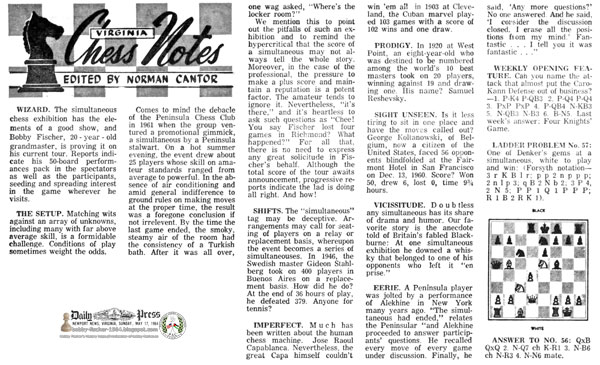Daily Press Newport News, Virginia Sunday, May 17, 1964 - Page 94
Bobby Fischer Proves His Elements on Current Exhibition Tour
WIZARD. The simultaneous chess exhibition has the elements of a good show, and Bobby Fischer, 20-year-old grandmaster, is proving it on his current tour. Reports indicate his 50-board performances pack in the spectators as well as the participants, seeding and spreading interest in the game wherever he visits.
THE SETUP. Matching wits against an array of unknowns, including many with far above average skill, is a formidable challenge. Conditions of play sometimes weight the odds.
Comes to mind the debacle of the Peninsula Chess Club in 1961 when the group ventured a promotional gimmick, a simultaneous by a Peninsula stalwart. On a hot summer evening, the event drew about 25 players whose skill on amateur standards ranged from average to powerful. In the absence of air conditioning and amid general indifference to ground rules on making moves at the proper time, the result was a foregone conclusion if not irrelevant. By the time the last game ended, the smoky, steamy air of the room had the consistency of a Turkish bath. After it was all over, one wag asked, “Where's the locker room?”
We mention this to point out the pitfalls of such an exhibition and to remind the hypercritical that the score of a simultaneous may not always tell the whole story. Moreover, in the case of the professional, the pressure to make a plus score and maintain a reputation is a potent factor. The amateur tends to ignore it. Nevertheless, “it's there,” and it's heartless to ask such questions as “Chee! You say Fischer lost four games in Richmond? What happened?” For all that, there is no need to express any great solicitude in Fischer's behalf. Although the total score of the tour awaits announcement, progressive reports indicate the lad is doing all right. And how!
SHIFTS. The “simultaneous” tag may be deceptive. Arrangements may call for seating of players on a relay or replacement basis, whereupon the event becomes a series of simultaneouses. In 1946, the Swedish master Gideon Stahlberg took on 400 players in Buenos Aires on a replacement basis. How did he do? At the end of 36 hours of play, he defeated 379. Anyone for tennis?
IMPERFECT. Much has been written about the human chess machine. Jose Raoul Capablanca. Nevertheless, the great Capa himself couldn't win 'em all in 1903 at Cleveland, the Cuban marvel played 103 games with a score of 102 wins and one draw.
PRODIGY. In 1920 at West Point, an eight-year-old who was destined to be numbered among the world's 10 best masters took on 20 players, winning against 19 and drawing one. His name? Samuel Reshevsky.
SIGHT UNSEEN. Is it less tiring to sit in one place and have the moves called out? George Koltanowski, of Belgium, now a citizen of the United States, faced 56 opponents blindfolded at the Fairmont Hotel in San Francisco on Dec. 13, 1960. Score? Won 50, drew 6, lost 0, time 9¾ hours.
VICISSITUDE. Doubtless any simultaneous has its share of drama and humor. Our favorite story is the anecdote told of Britain's fabled Blackburne: At one simultaneous exhibition he downed a whisky that belonged to one of his opponents who left it “en prise.”
EERIE. A Peninsula player was jolted by a performance of Alekhine in New York many years ago. “The simultaneous had ended,” relates the Peninsular “and Alekhine proceeded to answer participants' questions. He recalled every move of every game under discussion. Finally, he said, ‘Any more questions?’ No one answered. And he said, ‘I consider the discussion closed. I erase all the positions from my mind.’ Fantastic … I tell you it was fantastic …”
WEEKLY OPENING FEATURE. Can you name the attack that almost put the Caro-Kann Defense out of business?
—1. P-K4 P-QB3 2. P-Q4 P-Q4 3. PxP PxP 4. P-QB4 N-KB3 5. N-QB3 N-B3 6. B-N5. Last week's answer: Four Knights' Game.























